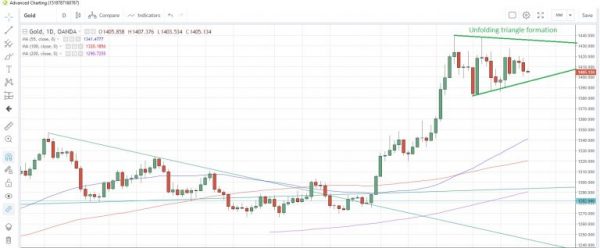Gold hit by dollar’s rise
US indices were little changed in Asia, though the story across other global indices was more mixed. Japan shares under-performed along with China and Hong Kong indices while Australian shares gained 0.57%. Trump’s comment that he still had the option of imposing higher tariffs on Chinese goods, despite agreeing to a truce on them last month, knocked US indices off their lofty pedestal yesterday.
The US dollar held on to the gains for the past two days in slow trade with AUD/USD sliding 0.1% to 0.7005 and USD/JPY sliding 0.08% to 108.15. Gold continued to consolidate lower within a triangle formation that has been unfolding since June 25, while oil prices steadied after touching a one-week low yesterday.
Gold Daily Chart
China to adopt a hard line?
The South China Morning Post reported that China had recently appointed a new face to the China negotiating team to face their US counterparts. Zhong Shan is seen as a bit of a hardliner and hawk which, the report suggests, implies China is in no hurry to wrap up the trade talks with the US and could even drag negotiations through to the 2020 US election. The report lays the blame for the trade conflict and resultant drag on the global economy fully on the US.
Consumer price data in the frame
A slew of price data for June populate the European calendar, with the UK releasing the retail price, producer price and consumer price indices for the month. Consumer prices have taken on more significance than the other two more recently, and CPI is seen flat on the month from May and up 2% on the year. This should not be too troubling for the Bank of England, whose monetary policy currently appears to be handcuffed to Brexit. Consumer prices in the Euro-zone are expected to rise 1.2% y/y and 0.1% m/m in the same month.
Heading across the pond to North America, housing starts and building permits data are on tap. Housing starts are forecast to rebound to +1.9% from May’s 0.9% decline while permits rose 0.7% last month. Canada’s consumer prices are expected to fall 0.2% last month from a month earlier, which would be the first negative print in six months, and may give the Bank of Canada a bit more leeway to follow the Fed’s lead in trimming rates.












